Solar to run a fridge.
Comments
-
Just wanted to show and tell..
Here is what my friend gave me when he moved into a smaller house. Didn't think he would need it anymore.
First came the inverter.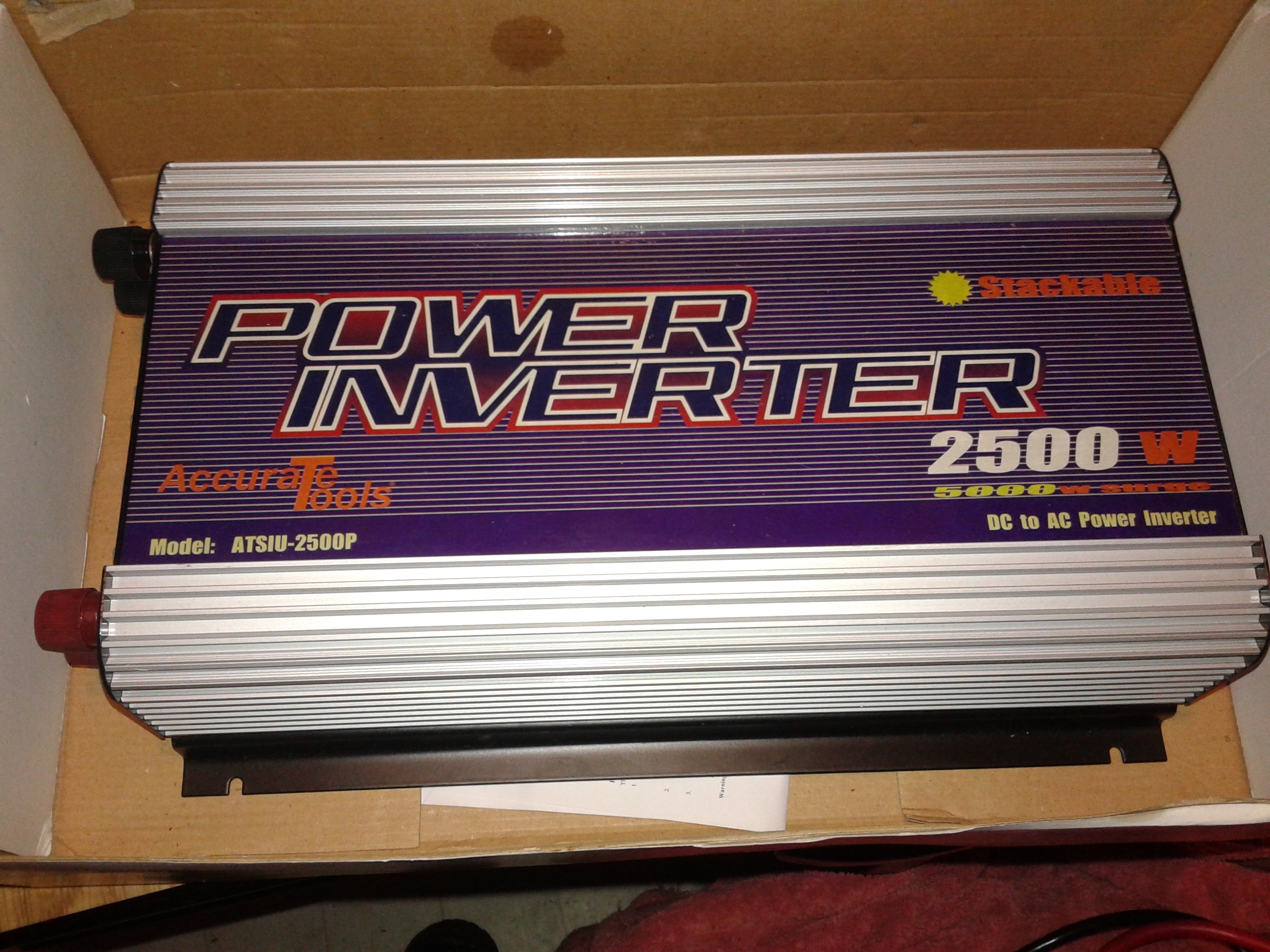





I figure i can use this inverter to power my old washing machine (not electronic) as well as my water pump.
Then a week later i'm over there helping move stuff around, and he hands me this stuff. . .
Brand new lightning arrestor still in the box.
2 resetable breakers.
So questions are,
1. where do i install the arrestor, and can it be inside the house or outside ?
2. will these breakers work if I put one on each positive line going into the inverters or would you recommend a better location ?
As for the batteries, i am looking into getting the smallest 6V batteries they have . . . which may be 110 amp hour . .so that would give me a 24 V 110 amp hour bank. bit smaller. Going to call em on monday to finalize.
2 - 255W + 4 - 285W PV - Tristar 60 amp MPPT CC / 3 - 110W PV -wired for 36V- 24V Sunsaver MPPT CC / midnite bat. monitor.
1 KW PSW inverter 24V / 2.5 KW MSW inverter-24V ~ 105 AHR battery.
3 ton GSHP.- 100 gallon warm water storage / house heat - radiant floor / rad
9 -220W PV - net meter - Enphase inverters and internet reporting system.
420 Gallon rain water system for laundry.*** 6" Rocket Mass Heater with 10' bed for workshop heat.Current project is drawing up plans for a below grade Hobbit / underground home.Google "undergroundandlovinit" no spaces. -
lightning arresters go outside. (unless you like bringing lightning indoors to play with)
Powerfab top of pole PV mount | Listeroid 6/1 w/st5 gen head | XW6048 inverter/chgr | Iota 48V/15A charger | Morningstar 60A MPPT | 48V, 800A NiFe Battery (in series)| 15, Evergreen 205w "12V" PV array on pole | Midnight ePanel | Grundfos 10 SO5-9 with 3 wire Franklin Electric motor (1/2hp 240V 1ph ) on a timer for 3 hr noontime run - Runs off PV ||
|| Midnight Classic 200 | 10, Evergreen 200w in a 160VOC array ||
|| VEC1093 12V Charger | Maha C401 aa/aaa Charger | SureSine | Sunsaver MPPT 15A
solar: http://tinyurl.com/LMR-Solar
gen: http://tinyurl.com/LMR-Lister , -
I have my batteries !
Label : DC31DT - DT is for double terminal
2 - 12 Volt . . . 105 amp hour (at least that is what I was told )
)
200 $ each.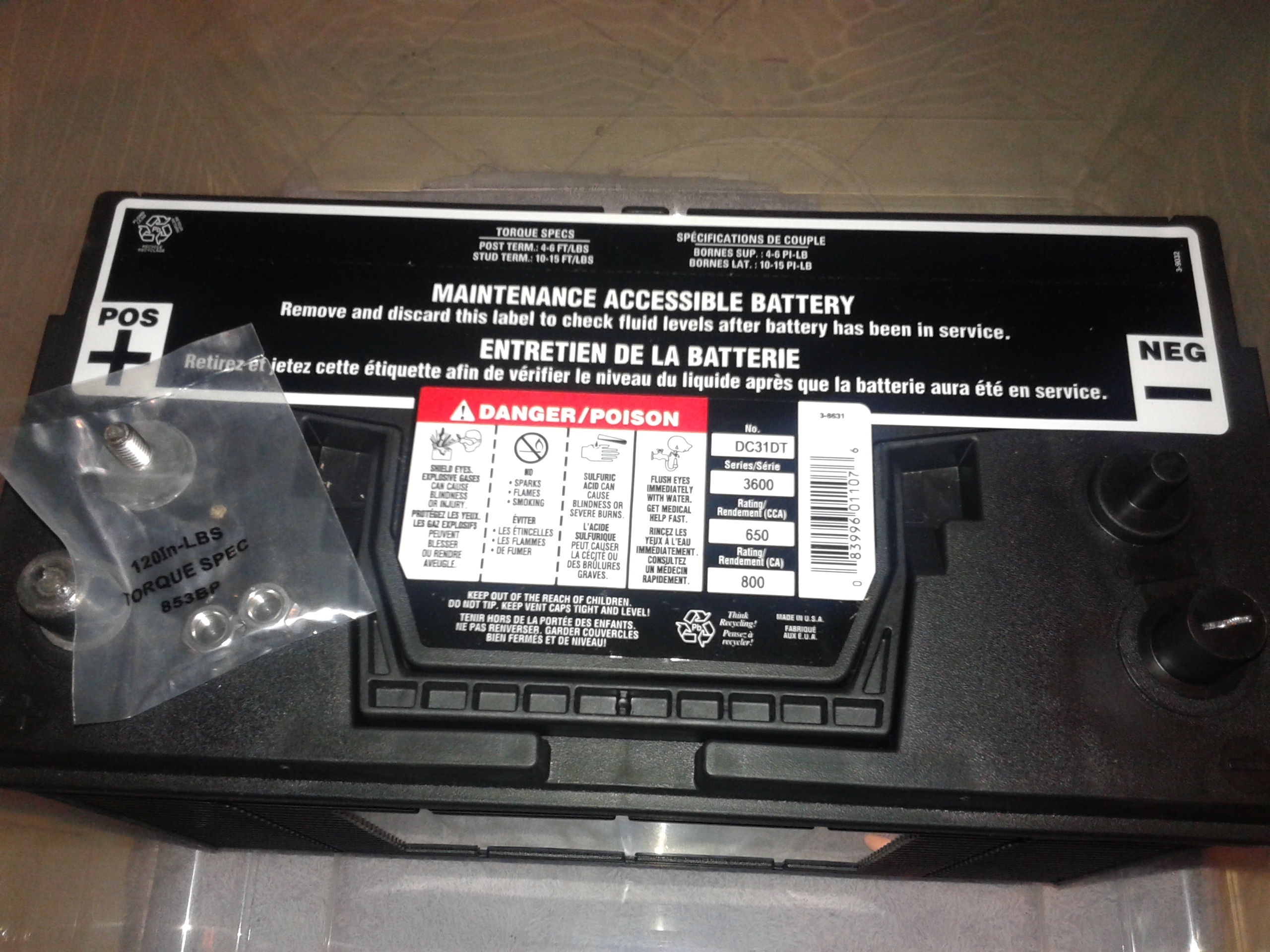

I had an idea about the hydrogen gas venting . . .
picked up a large plastic tub from wallie mart. . .


First thing would be too get some of that foam gasket material . . . and go all the way around the top edge of the container . . and then lock the lid down . . like this :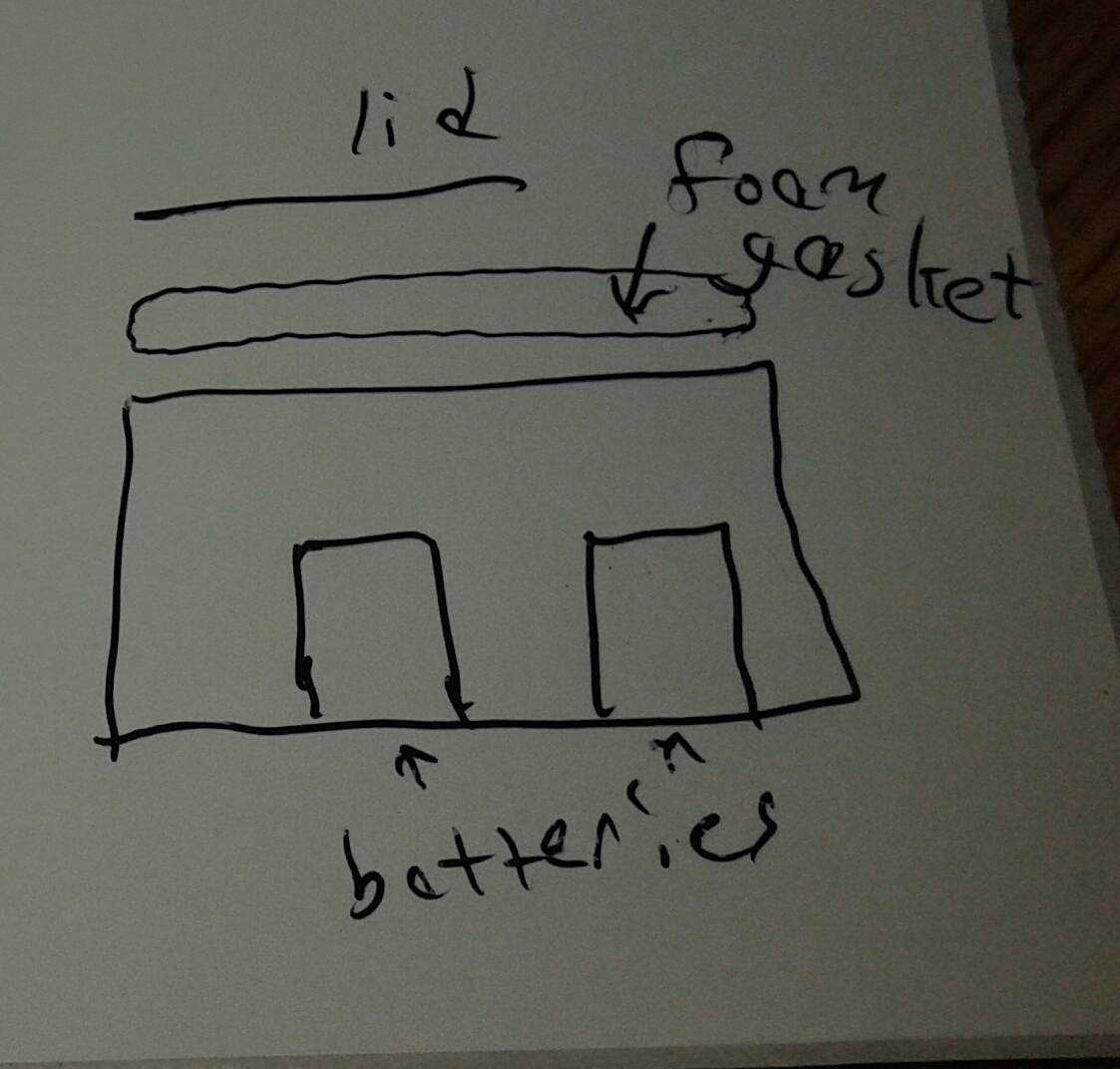
Then I was considering getting an abs screw type adapter seal the thread, and screw it into the lid. Then a 2 inch pipe adapter will sit over the 1.5 inch in the lid . . all I would need too do is too put a bead of foam gasket around the lip of the 2 inch pipe so when it sits on the lid, it creates a pressure seal . . . like this :
Since the upper pipe is not attached, I could lift the pipe a bit, and slide the whole container out from under it . .. then lift the lid . . at least that's the idea
This SEEMS alot easier than making a home made plywood container with a sloped lid and plexiglass top . . .
How small of a diameter could I narrow down too when I exit the building ? So I don't have too drill too big of a hole in the side of my house . . . or should I keep it to a min. of 1.5 inch pipe for draft ?
Any suggestions or ideas on this vent chamber idea are welcome . . .
I would like to thank you guys for the advice about getting batteries
2 - 255W + 4 - 285W PV - Tristar 60 amp MPPT CC / 3 - 110W PV -wired for 36V- 24V Sunsaver MPPT CC / midnite bat. monitor.
1 KW PSW inverter 24V / 2.5 KW MSW inverter-24V ~ 105 AHR battery.
3 ton GSHP.- 100 gallon warm water storage / house heat - radiant floor / rad
9 -220W PV - net meter - Enphase inverters and internet reporting system.
420 Gallon rain water system for laundry.*** 6" Rocket Mass Heater with 10' bed for workshop heat.Current project is drawing up plans for a below grade Hobbit / underground home.Google "undergroundandlovinit" no spaces. -
I personally do not like those plastic boxes... They tend to get brittle with age (a hand full of years)--In my experience.
You should check compatibility of plastic to sulfuric acid (aq):
http://www.plasticsintl.com/plastics_chemical_resistence_chart.html
Also--I worry about fire (shorted cable catches the plastic box on fire)--There are some advantages to plywood (slower burning, maintains shape when subjected to heat).
-Bill
Near San Francisco California: 3.5kWatt Grid Tied Solar power system+small backup genset -
Thanks Bill.BB. said:I personally do not like those plastic boxes... They tend to get brittle with age (a hand full of years)--In my experience.
Also--I worry about fire (shorted cable catches the plastic box on fire)--There are some advantages to plywood (slower burning, maintains shape when subjected to heat).
-Bill
I will keep an eye on the brittle plastic thing, and since I have fuses coming and going on all the wires of my system, hopefully the fire issue will not arise .. . see following post
edit : looked up sterilite plastic - polypropylene - no attack - slight absorption . . .
2 - 255W + 4 - 285W PV - Tristar 60 amp MPPT CC / 3 - 110W PV -wired for 36V- 24V Sunsaver MPPT CC / midnite bat. monitor.
1 KW PSW inverter 24V / 2.5 KW MSW inverter-24V ~ 105 AHR battery.
3 ton GSHP.- 100 gallon warm water storage / house heat - radiant floor / rad
9 -220W PV - net meter - Enphase inverters and internet reporting system.
420 Gallon rain water system for laundry.*** 6" Rocket Mass Heater with 10' bed for workshop heat.Current project is drawing up plans for a below grade Hobbit / underground home.Google "undergroundandlovinit" no spaces. -
Well, I thought I would go ahead and set up my system, so for better or worse, here goes . . .
First, applied foam gasket to the top of the battery container . . .
after that, I drilled a hole in the lid and fitted the abs pipe and sealed it with house sealant . .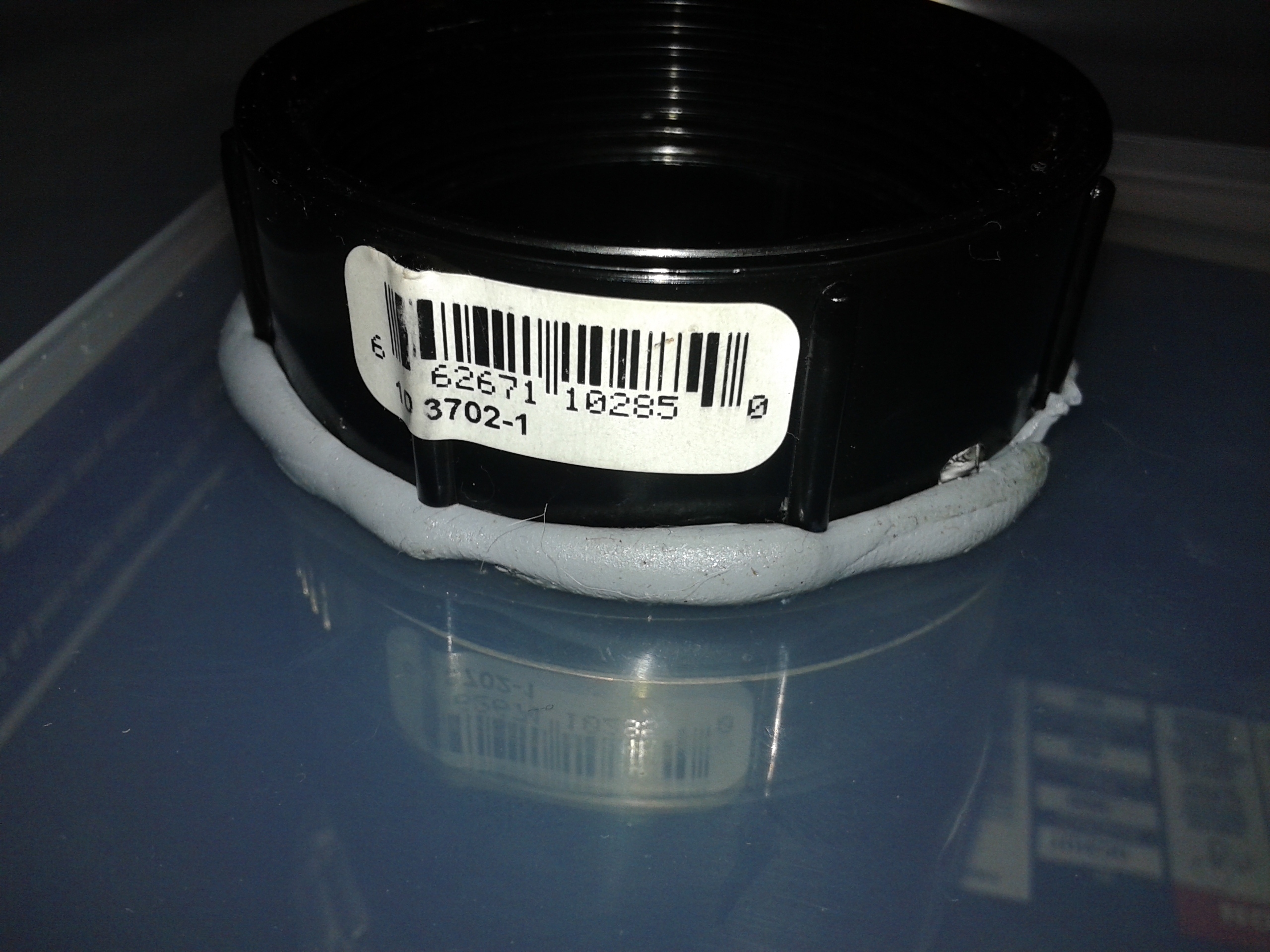
Did not want the lid to lift up and gas out in the house, so I added 6 one pound bags of sand as lid weights . . .
Then I wired the charge controller and inverter . . .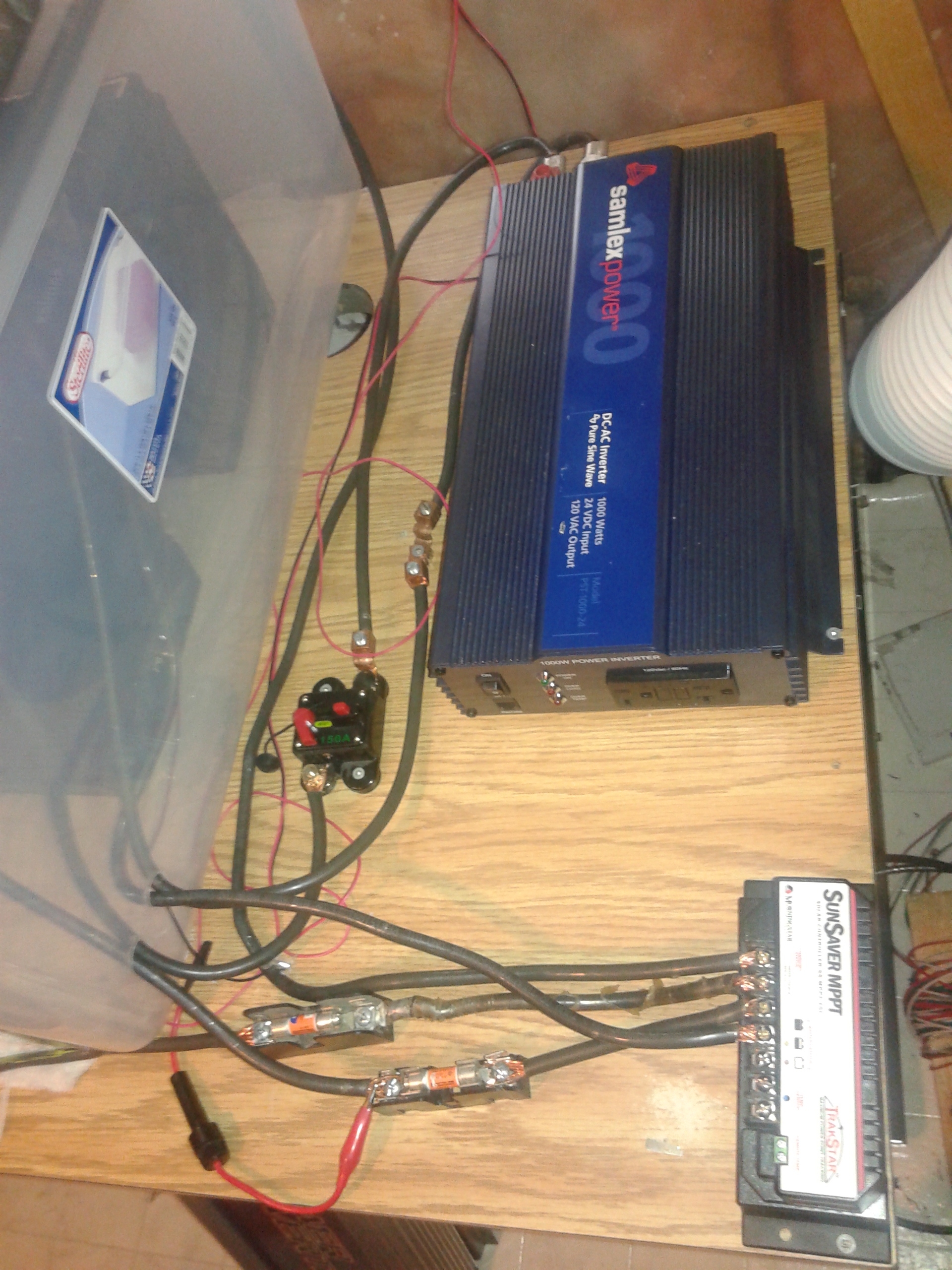
Fuses on the solar panel wires - at the top of the pole and before the CC.... fuse on + of the battery charge cable . . and the resettable breaker on the inverter out wire . . .
covered the end of the pipe going outside with a mesh screen to keep the bugs out, and its good too go . . .
Right ?
Now to get more panels . . . 2 - 255W + 4 - 285W PV - Tristar 60 amp MPPT CC / 3 - 110W PV -wired for 36V- 24V Sunsaver MPPT CC / midnite bat. monitor.
2 - 255W + 4 - 285W PV - Tristar 60 amp MPPT CC / 3 - 110W PV -wired for 36V- 24V Sunsaver MPPT CC / midnite bat. monitor.
1 KW PSW inverter 24V / 2.5 KW MSW inverter-24V ~ 105 AHR battery.
3 ton GSHP.- 100 gallon warm water storage / house heat - radiant floor / rad
9 -220W PV - net meter - Enphase inverters and internet reporting system.
420 Gallon rain water system for laundry.*** 6" Rocket Mass Heater with 10' bed for workshop heat.Current project is drawing up plans for a below grade Hobbit / underground home.Google "undergroundandlovinit" no spaces. -
You are aware that those are NOT deep cycle batteries, because they have a cranking spec listed on them, They are automotive starting batteries. 800 CA, 650 CCA
Powerfab top of pole PV mount | Listeroid 6/1 w/st5 gen head | XW6048 inverter/chgr | Iota 48V/15A charger | Morningstar 60A MPPT | 48V, 800A NiFe Battery (in series)| 15, Evergreen 205w "12V" PV array on pole | Midnight ePanel | Grundfos 10 SO5-9 with 3 wire Franklin Electric motor (1/2hp 240V 1ph ) on a timer for 3 hr noontime run - Runs off PV ||
|| Midnight Classic 200 | 10, Evergreen 200w in a 160VOC array ||
|| VEC1093 12V Charger | Maha C401 aa/aaa Charger | SureSine | Sunsaver MPPT 15A
solar: http://tinyurl.com/LMR-Solar
gen: http://tinyurl.com/LMR-Lister , -
mike95490 said:You are aware that those are NOT deep cycle batteries . . .
How do you figure that . . . . here is the listing for these batteries :East Penn - Deka Solar Flooded Monobloc Batteries: DC31DT

These low cost, high quality wet lead acid batteries are ideal for photovoltaic, attended applications. These small 6 and 12 VDC deep cycle batteries are the backbone of any autonomous power system and will deliver up to 1500 cycles at an 80 % depth of discharge.

# 01-14-032
12V LEAD ACID, DEEP CYCLE SOLAR BATTERY - 115 AHR2 - 255W + 4 - 285W PV - Tristar 60 amp MPPT CC / 3 - 110W PV -wired for 36V- 24V Sunsaver MPPT CC / midnite bat. monitor.
1 KW PSW inverter 24V / 2.5 KW MSW inverter-24V ~ 105 AHR battery.
3 ton GSHP.- 100 gallon warm water storage / house heat - radiant floor / rad
9 -220W PV - net meter - Enphase inverters and internet reporting system.
420 Gallon rain water system for laundry.*** 6" Rocket Mass Heater with 10' bed for workshop heat.Current project is drawing up plans for a below grade Hobbit / underground home.Google "undergroundandlovinit" no spaces. -
I also found this, since that picture does not match my batteries :
http://www.federalbatteries.com.au/DC31DT/
2 - 255W + 4 - 285W PV - Tristar 60 amp MPPT CC / 3 - 110W PV -wired for 36V- 24V Sunsaver MPPT CC / midnite bat. monitor.
1 KW PSW inverter 24V / 2.5 KW MSW inverter-24V ~ 105 AHR battery.
3 ton GSHP.- 100 gallon warm water storage / house heat - radiant floor / rad
9 -220W PV - net meter - Enphase inverters and internet reporting system.
420 Gallon rain water system for laundry.*** 6" Rocket Mass Heater with 10' bed for workshop heat.Current project is drawing up plans for a below grade Hobbit / underground home.Google "undergroundandlovinit" no spaces. -
I could give the guy a call and make sure, but everything points to these being flooded lead acid - deep cycle batteries . . .
2 - 255W + 4 - 285W PV - Tristar 60 amp MPPT CC / 3 - 110W PV -wired for 36V- 24V Sunsaver MPPT CC / midnite bat. monitor.
1 KW PSW inverter 24V / 2.5 KW MSW inverter-24V ~ 105 AHR battery.
3 ton GSHP.- 100 gallon warm water storage / house heat - radiant floor / rad
9 -220W PV - net meter - Enphase inverters and internet reporting system.
420 Gallon rain water system for laundry.*** 6" Rocket Mass Heater with 10' bed for workshop heat.Current project is drawing up plans for a below grade Hobbit / underground home.Google "undergroundandlovinit" no spaces. -
Not going to bother to call the salesman about these batteries . . .
Have a look at this pdf I located. . .
DC31DT is a Deep cycle - flooded lead acid batter
2 - 255W + 4 - 285W PV - Tristar 60 amp MPPT CC / 3 - 110W PV -wired for 36V- 24V Sunsaver MPPT CC / midnite bat. monitor.
1 KW PSW inverter 24V / 2.5 KW MSW inverter-24V ~ 105 AHR battery.
3 ton GSHP.- 100 gallon warm water storage / house heat - radiant floor / rad
9 -220W PV - net meter - Enphase inverters and internet reporting system.
420 Gallon rain water system for laundry.*** 6" Rocket Mass Heater with 10' bed for workshop heat.Current project is drawing up plans for a below grade Hobbit / underground home.Google "undergroundandlovinit" no spaces. -
Skippy said:Not going to bother to call the salesman about these batteries . . .
Have a look at this pdf I located. . .
DC31DT is a Deep cycle - flooded lead acid batter
I am with you Skippy, on this. Looks like the Deka DC31DT Is a true Deep Cycle battery, also look at this selector guide:
http://islandwaterworld.net/iww-files/pdf-description/LeadAcidBatteries.pdfOn that Selector, starting batteries are noted as Starting, Dual Purpose are so noted, as are Deep Cycle batteries.
One of my pet nagging points has long-been, that just because a battery manufacturer happens to list MCA, CCA and Reserve Capacity, that does not necessarily mean that it is just a Starting or Dual Purpose battery.
Some manufacturers like Surrette, list CCA, MCA and RC of essentially all of their Solar batteries, none of which are Dual Purpose or Starting batteries.
Here is an extreme example:
http://rollsbattery.com/wp-content/uploads/specsheets/2YS62P.pdfThat is a 570 Lb, 4860 Ah 2V battery with a CCA of 11,480 A, a MCA of 14,350 A, and a Reserve Capacity of 16,386 Minutes ... IMO this is probably NOT a Starting or Dual Purpose battery.
A number of manufacturers simply list just about anything that a buyer or user might want to know.
Looks like a nice start on your system Skippy.
Not to try to put too fine a point on battery types ... Cranky Vic
Off Grid - Two systems -- 4 SW+ 5548 Inverters, Surrette 4KS25 1280 AH X2@48V, 11.1 KW STC PV, 4X MidNite Classic 150 w/ WBjrs, Beta KID on S-530s, MX-60s, MN Bkrs/Boxes. 25 KVA Polyphase Kubota diesel, Honda Eu6500isa, Eu3000is-es, Eu2000, Eu1000 gensets. Thanks Wind-Sun for this great Forum. -
I based my comment on the Cranking Amps listing on the sticker of the battery in your photo. for a small battery, that is a large cranking amp spec
Powerfab top of pole PV mount | Listeroid 6/1 w/st5 gen head | XW6048 inverter/chgr | Iota 48V/15A charger | Morningstar 60A MPPT | 48V, 800A NiFe Battery (in series)| 15, Evergreen 205w "12V" PV array on pole | Midnight ePanel | Grundfos 10 SO5-9 with 3 wire Franklin Electric motor (1/2hp 240V 1ph ) on a timer for 3 hr noontime run - Runs off PV ||
|| Midnight Classic 200 | 10, Evergreen 200w in a 160VOC array ||
|| VEC1093 12V Charger | Maha C401 aa/aaa Charger | SureSine | Sunsaver MPPT 15A
solar: http://tinyurl.com/LMR-Solar
gen: http://tinyurl.com/LMR-Lister , -
I had Surrette batteries on my sailboat and they were (at that time) UL458 which is the standard for mobile power conversion products for vehicle application. For marine application, there is an extra supplemental certification to the UL458 standard that deals with vibration. My thinking is when cranking amps are listed the better makes of batteries are designed for and tested at design for vibration.
Not an issue offgrid."we go where power lines don't" Sierra Nevada mountain area
htps://offgridsolar1.com/
E-mail offgridsolar@sti.net -
If it has a large cranking amp spec, wouldn't that mean deep cycle vs a starter battery ?
No harm done, your just keeping me on my toes
edit : at 60 lbs a battery, I didn't think they were that small movin em around . ..
2 - 255W + 4 - 285W PV - Tristar 60 amp MPPT CC / 3 - 110W PV -wired for 36V- 24V Sunsaver MPPT CC / midnite bat. monitor.
1 KW PSW inverter 24V / 2.5 KW MSW inverter-24V ~ 105 AHR battery.
3 ton GSHP.- 100 gallon warm water storage / house heat - radiant floor / rad
9 -220W PV - net meter - Enphase inverters and internet reporting system.
420 Gallon rain water system for laundry.*** 6" Rocket Mass Heater with 10' bed for workshop heat.Current project is drawing up plans for a below grade Hobbit / underground home.Google "undergroundandlovinit" no spaces. -
I guess that deep cycle batteries have about ~80% of the cranking amps of a true Starting battery.
http://www.solar-electric.com/deep-cycle-battery-faq.html#Using a deep cycle battery as a starting battery-BillDeep Cycle Battery as a Starting Battery
There is generally no problem with this, providing that allowance is made for the lower cranking amps compared to a similar size starting battery. As a general rule, if you are going to use a true deep cycle battery (such as the Concorde SunXtender) also as a starting battery, it should be oversized about 20% compared to the existing or recommended starting battery group size to get the same cranking amps. That is about the same as replacing a group 24 with a group 31. With modern engines with fuel injection and electronic ignition, it generally takes much less battery power to crank and start them, so raw cranking amps is less important than it used to be. On the other hand, many cars, boats, and RV's are more heavily loaded with power sucking "appliances", such as megawatt stereo systems etc. that are more suited for deep cycle batteries. We have used the Concorde SunXtender AGM batteries in some of our vehicles with no problems.
It will not hurt a deep cycle battery to be used as a starting battery, but for the same size battery they cannot supply as much cranking amps as a regular starting battery and is usually much more expensive.
Near San Francisco California: 3.5kWatt Grid Tied Solar power system+small backup genset -
Me too Bill.
The understanding that most deep cycle batteries (except the Surrette Marine and others) are not designed for vibration.
If vibration is an issue, then it does not matter how big your deep cycle battery is, it may not survive a diesel engine near by or bashing into 14' waves."we go where power lines don't" Sierra Nevada mountain area
htps://offgridsolar1.com/
E-mail offgridsolar@sti.net -
That would be logical but there must be exceptions because 5 years ago I placed a pair of already well used 12v deep cycle Costco batteries into a farm tractor (didn't have anything more suitable available at the time). I expected they might only last the year but I've had no issues with them at all. And never needed to add water. I'd say the vibration they are exposed to exceeds any typical boating application.Dave Angelini said:Me too Bill.
The understanding that most deep cycle batteries (except the Surrette Marine and others) are not designed for vibration.
If vibration is an issue, then it does not matter how big your deep cycle battery is, it may not survive a diesel engine near by or bashing into 14' waves.
Seasonally off-grid ... 468 Ahrs @ 48V (8 Rolls S-605 6v FLA batteries), 24 x 130watt panels, 6 x 260watt panels, 2 x Midnite Classic 150, Whizbang Jr., Magnum MS4448PAE inverter/charger, 2 x Honda eu2000i generators paralleled. -
One of the things I wanted to do was boost the amount of insulation on the fridge.
So, I went out and purchased 2 sheets of 2 and 3/8 ths foam board. Replaced the foam on - back - both sides - both doors - but not the top since it was already 4 inches thick. Then replaced the older foam over top of the new stuff - except the back - not enough room between the coils and the back of the fridge.....
Here are the stand offs for the coils at the back of the fridge....

You can see in the above picture that I "straightened" the cooling tube a bit . . you don't want to move or bend these connections too much or you may damage the workings of the fridge . . .
I wanted to make sure that I would not have any problems with cold - damp surfaces condensing and causing mold, so I first covered the back of the joints with tape (I had lots of aluminum tape, so I used that - but any tape will keep the spray foam from sticking to the fridge) then spray foamed in between the foam panels to "glue" them together. Once the joints were foamed, I used more aluminum tape to pull the joints together and hold them until the foam cures.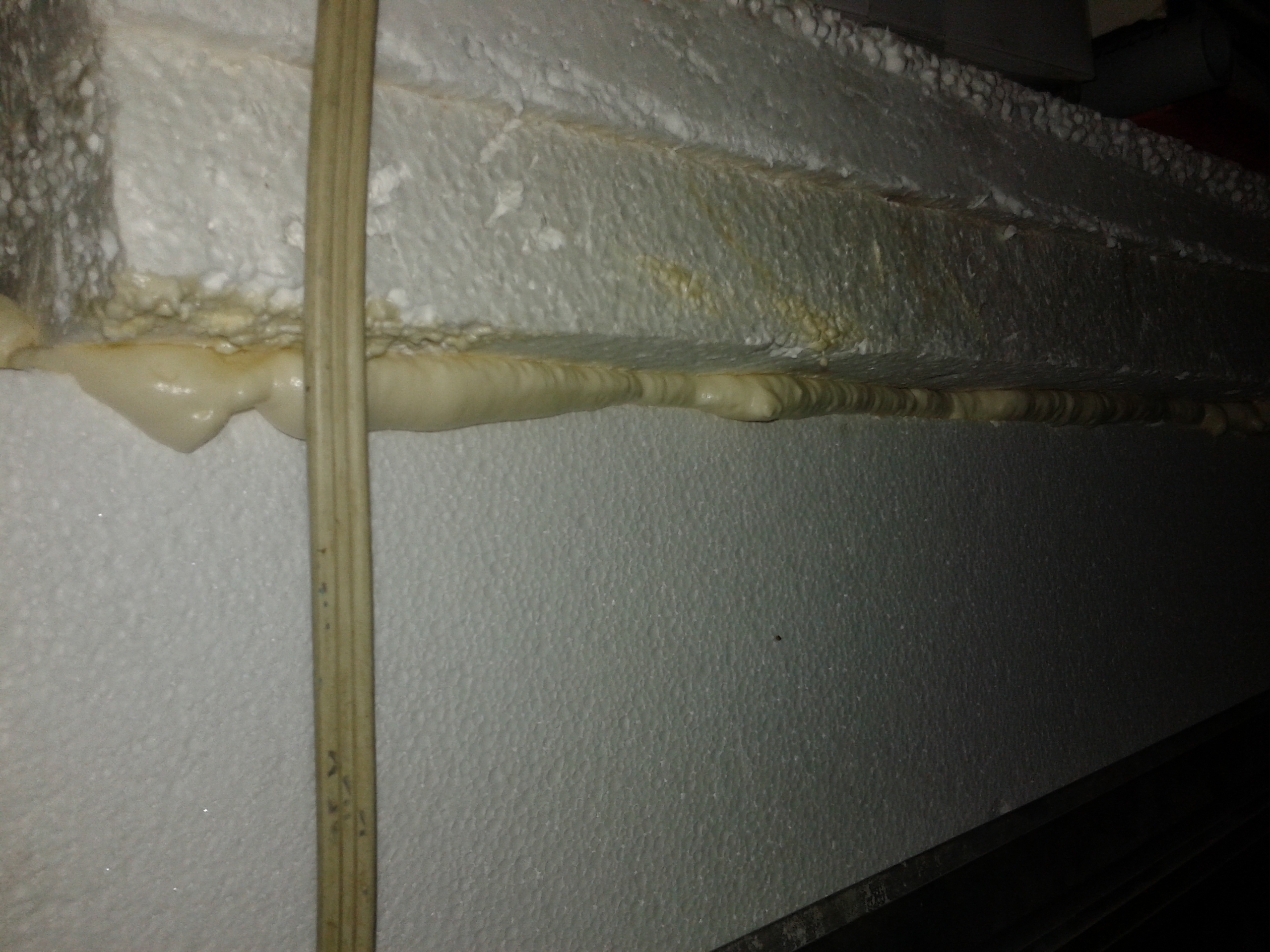


Above, you can see the older panels on top of the newer thicker panels, with the little bit of exposed fridge surface - but I had to leave the door hinge room to move . . . for the older panels, I just pushed 3 inch nails right thru both sheets. Holds them on nice and tight.
On the back of the fridge, I have upgraded by 3/8 ths of an inch. up too 2 3/8.
both sides and the front, upgraded by 2 and 3/8 ths of an inch. up too 4 3/8.
The top of the fridge is still 4 inches thick.
I will have to get you guys a KW reading on this beast over 24 hrs.
Now, lets see how the system works !
2 - 255W + 4 - 285W PV - Tristar 60 amp MPPT CC / 3 - 110W PV -wired for 36V- 24V Sunsaver MPPT CC / midnite bat. monitor.
1 KW PSW inverter 24V / 2.5 KW MSW inverter-24V ~ 105 AHR battery.
3 ton GSHP.- 100 gallon warm water storage / house heat - radiant floor / rad
9 -220W PV - net meter - Enphase inverters and internet reporting system.
420 Gallon rain water system for laundry.*** 6" Rocket Mass Heater with 10' bed for workshop heat.Current project is drawing up plans for a below grade Hobbit / underground home.Google "undergroundandlovinit" no spaces. -
I forgot to post this that last time, but when I first purchased the batteries, I could not get a hydrometer right away, and being the impatient person that I am, I hooked up the fridge with the old insulation on it . . . . and ran it for 2 days like that.
Once the batteries dropped to 50 % of charge, I disconnected the inverter, and left the batteries for 2 days too charge. By then, I was able to purchase a hydrometer, and was able too test the batteries after 2 full days of charging.
I then labeled the batteries #1 and #2 . . . with cells 1-6 and cells 7-12 for I.D. purposes . . .
Here are the results :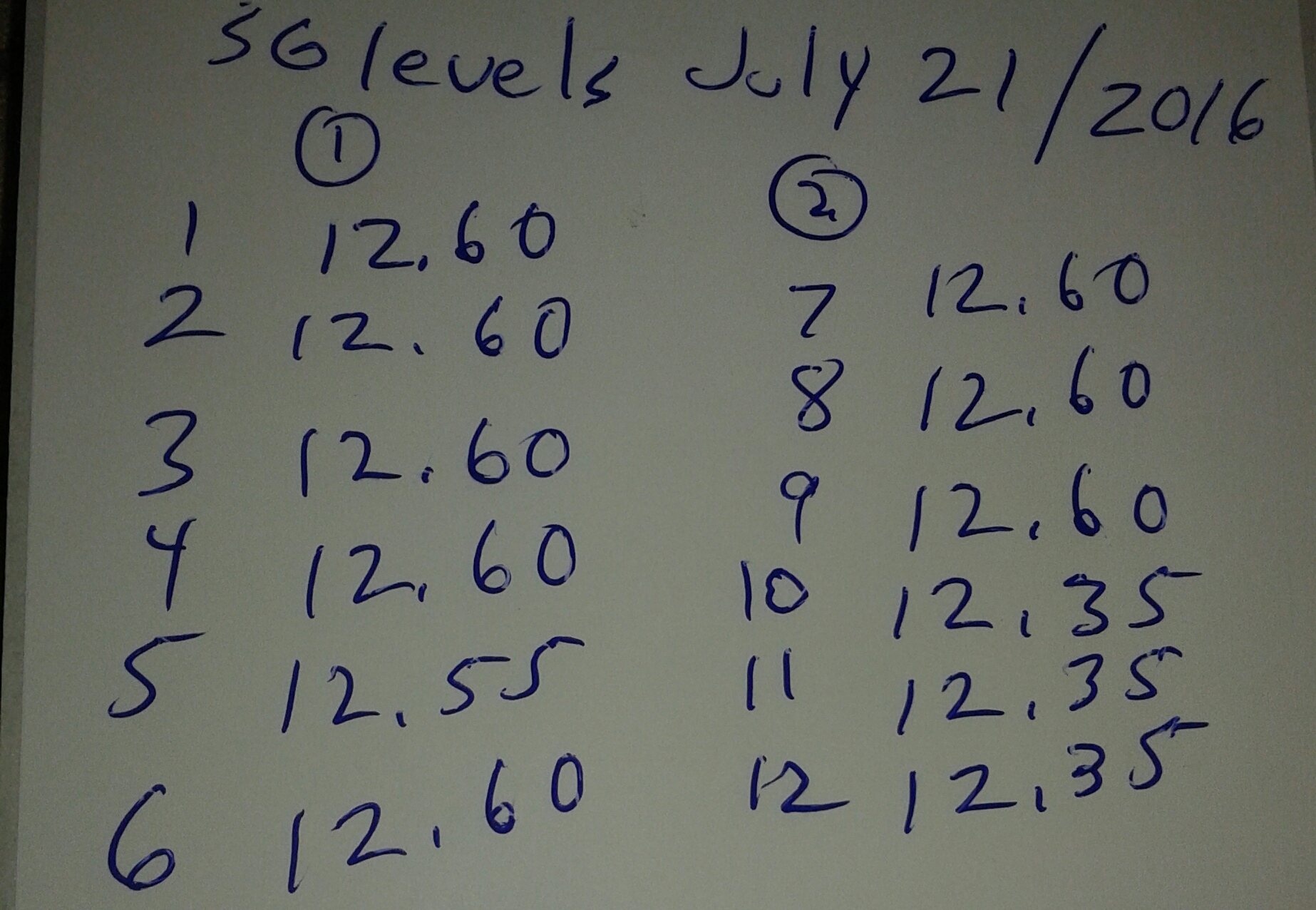
I was a bit concerned with the lower numbers on 10 - 11 and 12 . . . so I left the batteries on the panels for another day - with nothing else attached . . . and the lights on the charge controller were flashing too indicate "float" charging . . .
Next day I measured the cells again and all cells were reading between 12.55 and 12.60 . .. I am guessing that is a good thing
Keep u guys updated.
How often should I check the SG of all cells ? On one day, It was a bit cloudy, and the battery meter said 100 % while the light on the charge controller was indicating a 50% yellow light . .. next day full sun, and has been in the green ever since . . . ???
2 - 255W + 4 - 285W PV - Tristar 60 amp MPPT CC / 3 - 110W PV -wired for 36V- 24V Sunsaver MPPT CC / midnite bat. monitor.
1 KW PSW inverter 24V / 2.5 KW MSW inverter-24V ~ 105 AHR battery.
3 ton GSHP.- 100 gallon warm water storage / house heat - radiant floor / rad
9 -220W PV - net meter - Enphase inverters and internet reporting system.
420 Gallon rain water system for laundry.*** 6" Rocket Mass Heater with 10' bed for workshop heat.Current project is drawing up plans for a below grade Hobbit / underground home.Google "undergroundandlovinit" no spaces. -
Regarding insulating a refrigerator - I'd consider polyurethane insulation (more R value per inch) and plastic standoffs for the coil on the back. I'd also fill all unused internal space with water jugs - this provides more opportunities to load shift and also less on/off cycling.
I am available for custom hardware/firmware development
-
Any of you folks married? One of my friends did something like this to a refrigerator. When she got home, a call to the lawyer and a new refrigerator was delivered."we go where power lines don't" Sierra Nevada mountain area
htps://offgridsolar1.com/
E-mail offgridsolar@sti.net -
If they had too have a new fridge delivered, then the guy did it wrong.Dave Angelini said:a new refrigerator was delivered.
These insulation sheets are stuck on with 4 - 1" rare earth magnets with an individual pull test of 30 lbs each.
The reason I backed each joint of the foam before spraying in the spray foam, was too keep it from sticking too the fridge.
If my honey does not like having a massive 4 inch thick pin cushion / bulletin board - I can always rip it all off . . no harm done.
Not gonna happen. She is watching the hydro bill as much as I am . . .
2 - 255W + 4 - 285W PV - Tristar 60 amp MPPT CC / 3 - 110W PV -wired for 36V- 24V Sunsaver MPPT CC / midnite bat. monitor.
1 KW PSW inverter 24V / 2.5 KW MSW inverter-24V ~ 105 AHR battery.
3 ton GSHP.- 100 gallon warm water storage / house heat - radiant floor / rad
9 -220W PV - net meter - Enphase inverters and internet reporting system.
420 Gallon rain water system for laundry.*** 6" Rocket Mass Heater with 10' bed for workshop heat.Current project is drawing up plans for a below grade Hobbit / underground home.Google "undergroundandlovinit" no spaces. -
For those of you following my progress on trying to run my fridge off solar, here is an update for ya...
I upgraded the foam on my fridge, from 2 inch up too 2 and 3/8 ths inch . . . hooked up the solar system , and waited too see what happened.
Well, in the first day, the battery dropped down too 50 % . .
All indicators were green - fully charged....
recharged off the solar, and the next day, it dropped down too 10 %...
What the heck . . .
So . . I pulled out the Kill-o-watt meter, and found that by upgrading to the thicker foam, I had unknowingly put the compressor coils too close to the foam on the back . . . at the bottom of the coil , it was almost touching the foam . . . which means there was very little air flow around the coils, and the fridge would run harder too cool itself off . . .
Here is the meter after 24 hours
At one point, it was at a high of .95 kwh... no wonder the batteries were dying !
While I was trying to figure all this out, I shut down the inverter, and left it too recharge the batteries. It took 2 weeks to reach an SG of 1.250 and I think it should still be higher - right ? (question at the end of the post)
So, I removed the old standoffs - off the back of the fridge, and reinstalled a set of 4 standoffs extended another 2 inches - gently bending the coils at the bottom (very gently !) until they fit into the places the old ones fit.
After 24 hours, the k.w meter looked like this :
That is alot better than what it was, so as of today, I plugged the fridge back into the batteries and will see how it goes.
Because of that, I called up my solar guy, and ordered another 2 panels at 1 $ a watt... here is the info:
Mounted them on a custom - top of pole mount, and wired them into the house...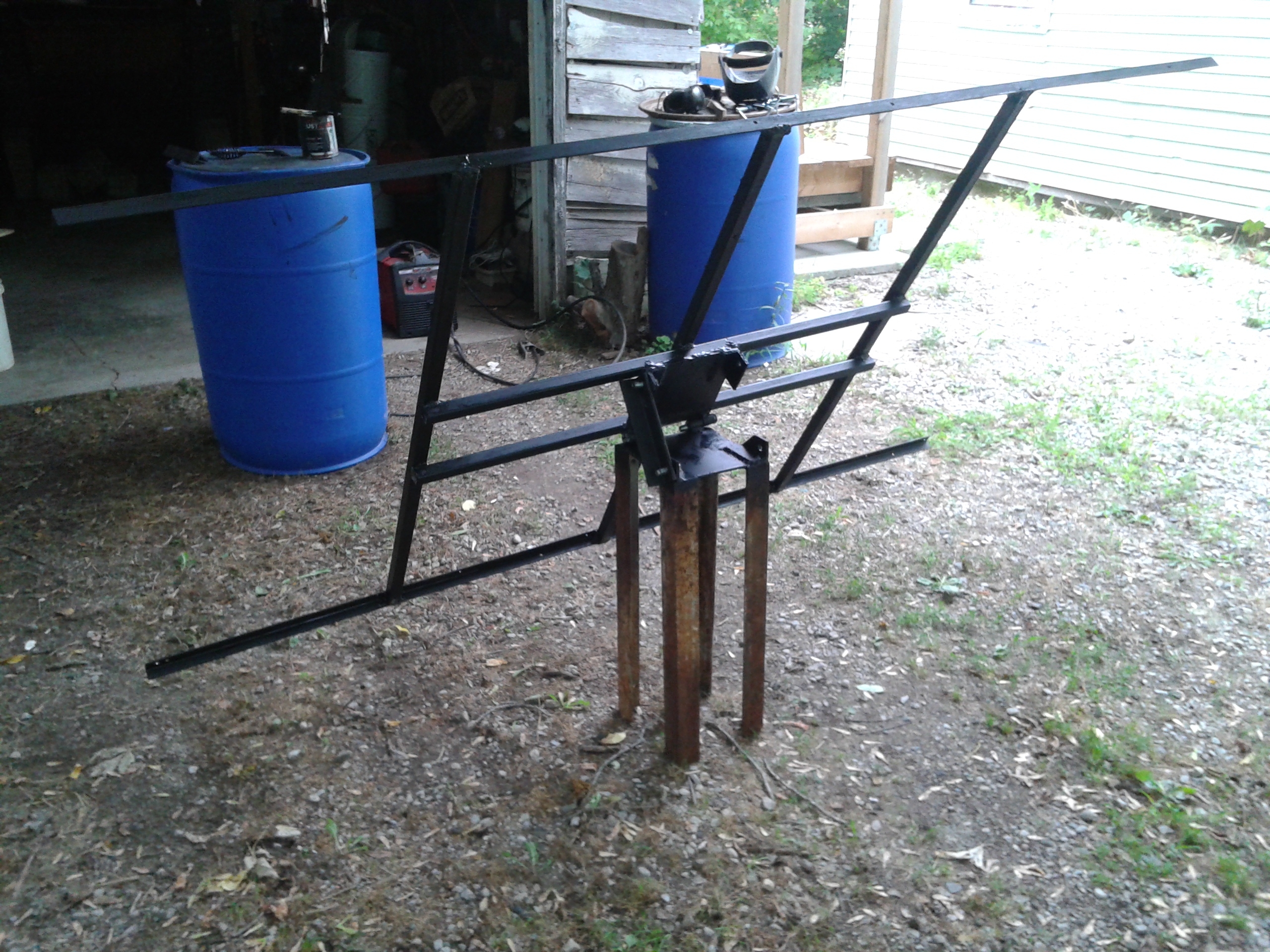
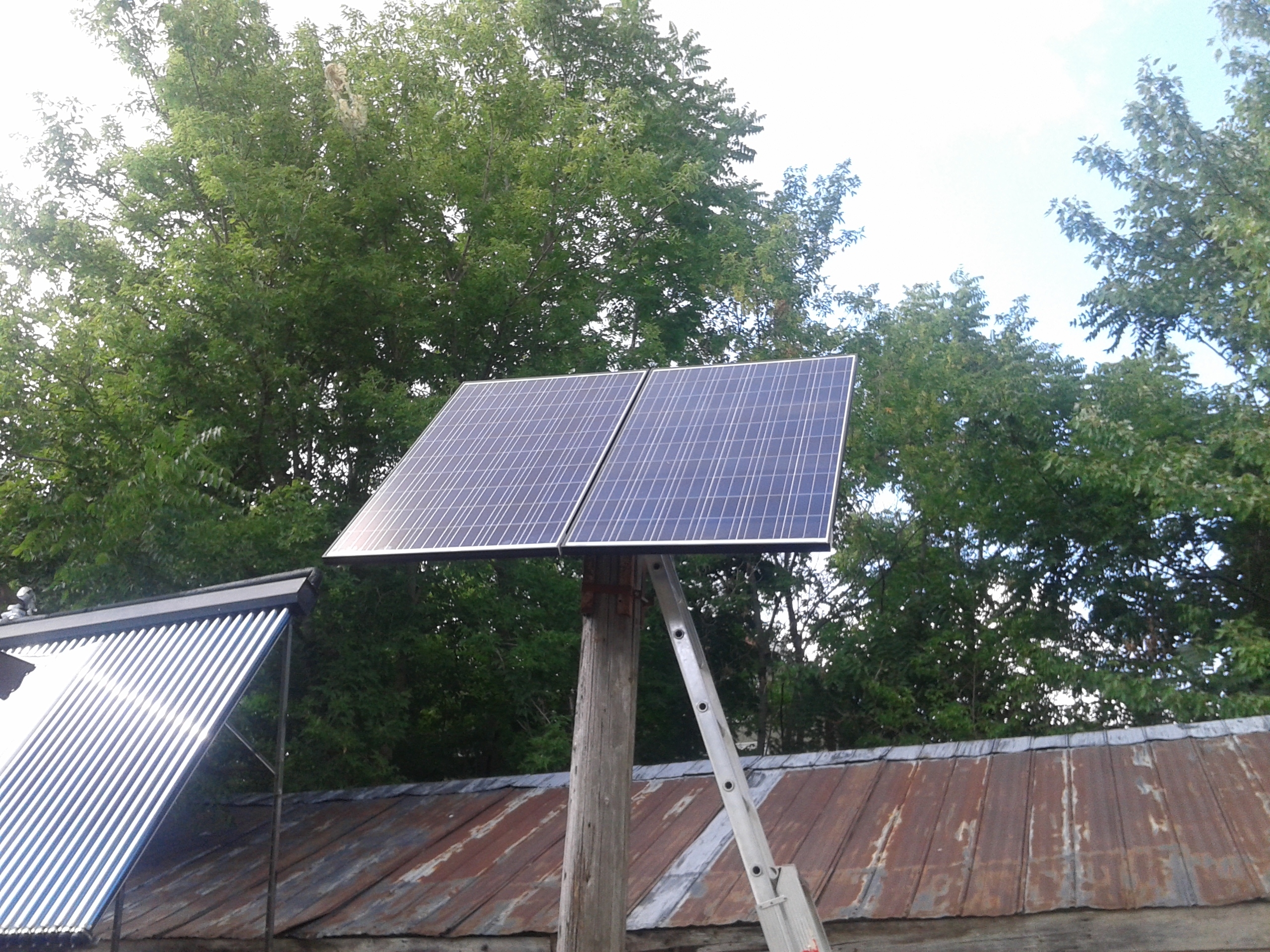
I then called A.W.S. and ordered up a tristar 40 - now working on getting it here.
With the addition of these 2 panels and the three that I already have, I will have (510+330) roughly 840 watts of panels - I know I am over paneled on the battery bank, but , in the cold Canadian winters, more is better, and hopefully, in the summertime, I can run the washing machine every now and then.
So, the questions are:
1. is a 2 week recharge of a 100 + amp hour battery bank at 24 V (when it is down too 10 percent capacity or 90 % discharged)- using my small 330 watt panels ? checked the power at the terminals, and the CC is getting 60 + volts from the panels...
2. I will have to call my battery guy, but is an SG of 1.250 considered "charged" or should it be higher ? Considering I just checked em and they were at 1.265 - I think they are not charging fully . .....
I hope, that with the addition of the extra panels, I will be able to get a good equalize charge to the batteries - making sure that the batteries are fully charged. - while the purchase of good equipment will keep the batteries from getting overcharged....
Will keep you guys updated.
2 - 255W + 4 - 285W PV - Tristar 60 amp MPPT CC / 3 - 110W PV -wired for 36V- 24V Sunsaver MPPT CC / midnite bat. monitor.
1 KW PSW inverter 24V / 2.5 KW MSW inverter-24V ~ 105 AHR battery.
3 ton GSHP.- 100 gallon warm water storage / house heat - radiant floor / rad
9 -220W PV - net meter - Enphase inverters and internet reporting system.
420 Gallon rain water system for laundry.*** 6" Rocket Mass Heater with 10' bed for workshop heat.Current project is drawing up plans for a below grade Hobbit / underground home.Google "undergroundandlovinit" no spaces. -
Good Night....all this discussion on how to "hop up" freezers and refrigerators almost makes my head hurt. My gut feeling is there exists an excellent chance that changes could backfire.
Or should I bravely surround my 2016 Danby freezer and 2004 Samsung fridge with mondo insulation?
First Bank:16 180 watt Grape Solar with FM80 controller and 3648 Inverter....Fullriver 8D AGM solar batteries. Second Bank/MacGyver Special: 10 165(?) watt BP Solar with Renogy MPPT 40A controller/ and Xantrex C-35 PWM controller/ and Morningstar PWM controller...Cotek 24V PSW inverter....forklift and diesel locomotive batteries -
Skippy, er the charging... you have not mentioned if you made it to float, the settings for Absorb or Float. Especially how many hours of Absorb they get... this is where a MidNite Kid or Classic with a WBjr shines...
KID #51B 4s 140W to 24V 900Ah C&D AGM
CL#29032 FW 2126/ 2073/ 2133 175A E-Panel WBjr, 3 x 4s 140W to 24V 900Ah C&D AGM
Cotek ST1500W 24V Inverter,OmniCharge 3024,
2 x Cisco WRT54GL i/c DD-WRT Rtr & Bridge,
Eu3/2/1000i Gens, 1680W & E-Panel/WBjr to come, CL #647 asleep
West Chilcotin, BC, Canada -
The way I look at the whole "insulate the fridge" thing, is this :softdown said:Good Night....all this discussion on how to "hop up" freezers and refrigerators almost makes my head hurt. My gut feeling is there exists an excellent chance that changes could backfire.
Or should I bravely surround my 2016 Danby freezer and 2004 Samsung fridge with mondo insulation?
You have a box sitting in your kitchen.
The compressor comes on and cools it off.
over time, the box heats up too room temp.
the compressor comes on and cools it off.
and so on - and so on.
By adding insulation to the box, I am not cutting wires, or changing the electronics. I am just keeping the heat out, and the cold in.
It cycles less, using less hydro. Thats it.
If you want to do an experiment, plug your fridge into a kill-a-watt meter, measure 24 hours - then using hot melt glue, stick a piece of 2 inch styrofaom to the outside of it - doing only 1 side (even the top) should make a difference on the meter over the next 24 hours. Keep adding foam until it's all covered - and you max out your savings. I suggest using hot melt glue, since once it cools off, it is easy too peel off the surface.
NOTE ! ---- DO NOT COVER ANY SURFACE THAT IS HOT OR WARM TO THE TOUCH....this is where your fridge is loosing the heat from the compressor unit and it WILL overheat and burn it out.
2 - 255W + 4 - 285W PV - Tristar 60 amp MPPT CC / 3 - 110W PV -wired for 36V- 24V Sunsaver MPPT CC / midnite bat. monitor.
1 KW PSW inverter 24V / 2.5 KW MSW inverter-24V ~ 105 AHR battery.
3 ton GSHP.- 100 gallon warm water storage / house heat - radiant floor / rad
9 -220W PV - net meter - Enphase inverters and internet reporting system.
420 Gallon rain water system for laundry.*** 6" Rocket Mass Heater with 10' bed for workshop heat.Current project is drawing up plans for a below grade Hobbit / underground home.Google "undergroundandlovinit" no spaces. -
Sorry it took so long westbranch . . other things going on . . .westbranch said:Skippy, er the charging... you have not mentioned if you made it to float, the settings for Absorb or Float. Especially how many hours of Absorb they get... this is where a MidNite Kid or Classic with a WBjr shines...
This charge controller I have here only has a little flashing light . . slow flashing light- once every second means float - seen that one. . . . fast flashing light - once every half second means equalize. . have not seen that one yet . . . that s all I have too go by . .
BUT . . .
I have ordered a tristar 45 with the optional meter to be able to monitor the new panels output and settings . . along with that order is the modbus adapter for the charge controller that I have here, so I can hook it up to my computer and see what the settings are set at . . . that little idiot light on the top of the thing does not tell me anything . . with the adapter, I should be able to tell you guys alot more information than "its flashing"
Keep ya updated...
2 - 255W + 4 - 285W PV - Tristar 60 amp MPPT CC / 3 - 110W PV -wired for 36V- 24V Sunsaver MPPT CC / midnite bat. monitor.
1 KW PSW inverter 24V / 2.5 KW MSW inverter-24V ~ 105 AHR battery.
3 ton GSHP.- 100 gallon warm water storage / house heat - radiant floor / rad
9 -220W PV - net meter - Enphase inverters and internet reporting system.
420 Gallon rain water system for laundry.*** 6" Rocket Mass Heater with 10' bed for workshop heat.Current project is drawing up plans for a below grade Hobbit / underground home.Google "undergroundandlovinit" no spaces. -
I would like to thank you guys for all the help and advice - while I have been trying to get this system up and running.
Here is an update on my "small system" :
The tristar charge controller was finally delivered. With the addition of a second charging system, I did not want a bunch of loose wires lying around, so this time I went with a "cleaner" looking install.
Here is the finished wiring on the solar side of the batteries :
On the inverter side of the batteries, I still have to figure out how to fit it into conduit, but the system is up and running...
Now comes the thank you for the advice . . . When I first installed the tristar, I had the battery settings as high as they would go . . for L16 batteries !
Charged the batteries for a couple of days, and then checked the SG levels . . the SG reading was 1.30 (way too high)
So, not really having any idea of what I was doing ( I admit it ) . . I took the advice from here and contacted the guys who sold me the batteries. They informed me that these batteries should have an SG of 1.25 - tops. Mine were way over charged.
So, after getting the proper settings list from the supplier I reset the switches and plugged in the fridge. Running the fridge brought the SG back down, while resetting the switches ensured proper charging.
After a couple of days, of running the fridge with no problems at all - meter reads 100 % at 6 am ! I had an absorption reading of 28.8 ... so just to be absolutely sure that I was not killing my batteries . . . I called the battery guy again, and asked if I had the right settings - I was then informed that I was 1 full volt on the low side.... undercharging.
I had an absorption reading of 28.8 ... so just to be absolutely sure that I was not killing my batteries . . . I called the battery guy again, and asked if I had the right settings - I was then informed that I was 1 full volt on the low side.... undercharging.
Looked at the chart again (above) and realized that I had used the center chart for my settings - when the chart at the far right is the one that I needed to use..... reset the switches again, and now have a maximum absorption voltage of 29.4
Now for the fun part.
Nice sunny day outside, battery fully charged (with the right settings) tried to do a load of laundry.
Started up the washer - and the 2.5 k.w. inverter would not start the washer - low voltage disconnect - I am going to try hooking up heavier wires - wires are probably too small from battery to inverter . . it is 2.5 KW after all . . .
Plugged in the washer to the grid and ran it for a count of 5 - then plugged it into the inverter - runs the washer just fine when it's warmed up first.
Ran the washer for 15 minutes - Voltage reading on the tristar dropped from 29.4 - slowly down to 25.5 and stayed at that voltage. - with all 5 pv panels feeding the load.
After 15 minutes, the fridge came on !
The voltage on the tristar dropped from 25.5 down to 24.9 V
Over the next 30 minutes that it took to run a wash cycle - refilled using the pump in the basement (rainwater) -spin dry - refill again - rinse- spin dry - the voltage dropped down to 24.7 - the whole time the fridge was running in the background.
The interesting thing is, that the midnite battery meter did not start moving until the voltage dropped below 24.9 V....
Once the Voltage dropped below 24.9, the midnite meter dropped 10 % every 10 minutes - so, by the time the laundry was done (right after that the fridge shut off) the midnite was flipping between 70 and 80 % DOD. - the lowest reading on the tristar ws 24.7 V.
Test results are :
Runs the fridge off grid easily - with the batteries overnight - in the morning I have 100 % showing on the midnite - 25 to 26 V showing on the tristar.
Runs the washer (by itself) and holds the voltage at 25.5 - but it has too be a sunny day.
Will run both the fridge and the washer together -in full sun - but it draws the batteries down more than I would like . . . so next time I will wait for the fridge to cycle before doing laundry. Since I cannot unplug the fridge or it will force a defrost cycle / cooling cycle it has too stay plugged in.
If you guys see any problems, let me know please.
Now, how do I ground this thing ...
Again, thank you for all your help.
2 - 255W + 4 - 285W PV - Tristar 60 amp MPPT CC / 3 - 110W PV -wired for 36V- 24V Sunsaver MPPT CC / midnite bat. monitor.
1 KW PSW inverter 24V / 2.5 KW MSW inverter-24V ~ 105 AHR battery.
3 ton GSHP.- 100 gallon warm water storage / house heat - radiant floor / rad
9 -220W PV - net meter - Enphase inverters and internet reporting system.
420 Gallon rain water system for laundry.*** 6" Rocket Mass Heater with 10' bed for workshop heat.Current project is drawing up plans for a below grade Hobbit / underground home.Google "undergroundandlovinit" no spaces. -
It is difficult to tell--But from your pictures, I would guess that your wiring is too small of diameter (AWG) and too long.
For example, a 2,500 Watt inverter running on a 24 volt battery bank can draw as much as (and 2x this amount for surge current to ~5kWatt):- 2,500 Watts * 1/0.85 inverter eff * 1/21.0 volts "batt cutoff" = 140 Amps
- 140 Amps * 1.25 NEC derating = 175 Amp branch circuit (wiring+breakers minimum).
http://lugsdirect.com/WireCurrentAmpacitiesNEC-Table-301-16.htm
Somewhere around 2/0 to 4/0 wiring.
And for wire length--Say (guess) you have 6 feet (one way wire run) of 6 AWG wiring, using a simple voltage drop calculator for 140 amps (remember, inverter can draw as much as 280 amps starting surge):
http://www.calculator.net/voltage-drop-calculator.html?material=copper&wiresize=1.296&voltage=23&phase=dc&noofconductor=1&distance=6&distanceunit=feet&eres=140&x=69&y=4
Voltage drop: 0.66
Voltage drop percentage: 2.87%
Voltage at the end: 22.34 (based on 23.0 volt battery bus)
6 AWG could work in terms of voltage drop, but for safety (and better surge support--I am guessing at your AWG and cable lengths), short/heavy gauge wire is really needed for DC input to AC inverters.
Also, It looks like you use a breaker in both the Hot and Neutral path--While that can work--Generally if your battery negative bus is grounded, just one breaker in the positive path is fine (and less voltage drop--breakers+fuses have voltage drops themselves).
Also measure the voltage at teh battery bus (see how the battery bank is performing) and at the AC inverter DC input terminals (see how the wiring is working out) at full operational load(s).
-Bill
Near San Francisco California: 3.5kWatt Grid Tied Solar power system+small backup genset
Categories
- All Categories
- 233 Forum & Website
- 141 Solar Forum News and Announcements
- 1.4K Solar News, Reviews, & Product Announcements
- 200 Solar Information links & sources, event announcements
- 900 Solar Product Reviews & Opinions
- 256 Solar Skeptics, Hype, & Scams Corner
- 22.5K Solar Electric Power, Wind Power & Balance of System
- 3.5K General Solar Power Topics
- 6.7K Solar Beginners Corner
- 1K PV Installers Forum - NEC, Wiring, Installation
- 2.1K Advanced Solar Electric Technical Forum
- 5.6K Off Grid Solar & Battery Systems
- 429 Caravan, Recreational Vehicle, and Marine Power Systems
- 1.1K Grid Tie and Grid Interactive Systems
- 656 Solar Water Pumping
- 817 Wind Power Generation
- 624 Energy Use & Conservation
- 623 Discussion Forums/Café
- 315 In the Weeds--Member's Choice
- 75 Construction
- 125 New Battery Technologies
- 108 Old Battery Tech Discussions
- 3.8K Solar News - Automatic Feed
- 3.8K Solar Energy News RSS Feed

